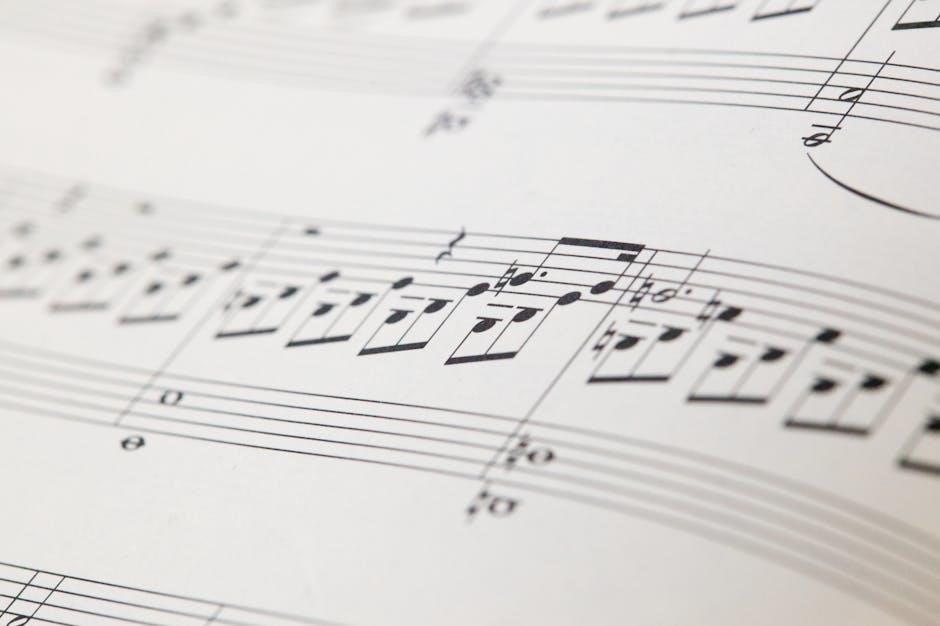
treble clef notes pdf
Delving into treble clef notes unlocks a world of musical expression, offering access to countless piano pieces and compositions․
Resources like free treble clef notes PDF worksheets provide a structured path for beginners to grasp fundamental concepts․
Understanding these notes is crucial for reading sheet music, interpreting melodies, and ultimately, enjoying the art of music creation․
The provided text references watercolour paintings and online Barbie games, seemingly unrelated to musical notation, yet highlighting the diverse content available online․
These digital resources, alongside dedicated PDF guides, empower aspiring musicians to learn at their own pace and explore their musical potential․
Mastering the treble clef is the first step towards a fulfilling journey in music, opening doors to a vast repertoire of beautiful melodies․
What is the Treble Clef?
The treble clef, also known as the G clef, is a symbol that indicates the pitch of musical notes written on a staff․ Its elegant swirl encircles the second line from the bottom, designating that line as the note G above middle C․ This foundational symbol is predominantly used for higher-pitched instruments and voices, including the piano’s right hand, flute, violin, and soprano vocals․
Historically, the treble clef evolved from the letter ‘G’, a visual reminder of its defining note․ Understanding its purpose is paramount when utilizing resources like treble clef notes PDF worksheets․ These PDFs often visually demonstrate how the clef anchors the musical staff, providing a framework for identifying note names and their corresponding pitches․
The information retrieved mentions unrelated content like Barbie games and watercolour paintings, but the core concept remains: access to information․ Similarly, a treble clef notes PDF provides accessible information for musical learning․ The clef isn’t a note itself, but a guide, a map to decipher the language of music, making it essential for anyone embarking on a musical journey․
It’s the key to unlocking melodies and harmonies, and a crucial component in reading and understanding sheet music․
Why Learn Treble Clef Notes?
Learning treble clef notes is fundamental for anyone aspiring to read, play, or compose music․ It unlocks access to a vast repertoire of musical literature, from classical masterpieces to contemporary pop songs․ Proficiency in reading treble clef allows musicians to interpret sheet music accurately, fostering independence and musical expression․
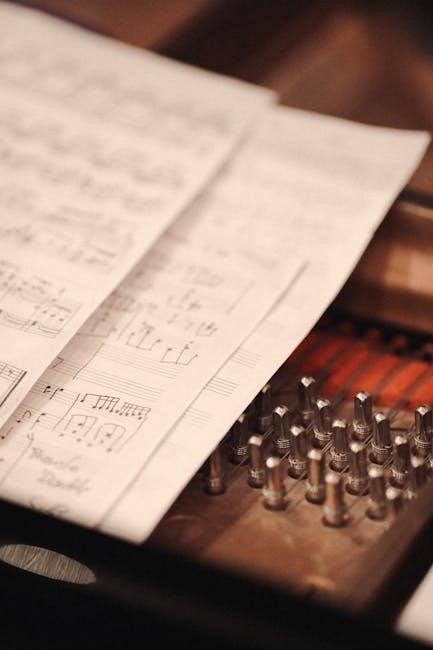
Utilizing resources like treble clef notes PDF worksheets accelerates the learning process․ These PDFs offer structured exercises and visual aids, making note recognition more intuitive․ The ability to decipher notes empowers musicians to learn new pieces efficiently, collaborate with others, and even create their own compositions․
While seemingly unrelated, the provided text referencing Barbie games and artwork highlights the abundance of online resources․ Similarly, readily available PDFs democratize music education, offering affordable and accessible learning tools․ Mastering the treble clef isn’t just about recognizing symbols; it’s about understanding the language of music, fostering creativity, and deepening one’s appreciation for the art form․
It’s a gateway to a lifetime of musical enjoyment and fulfillment․
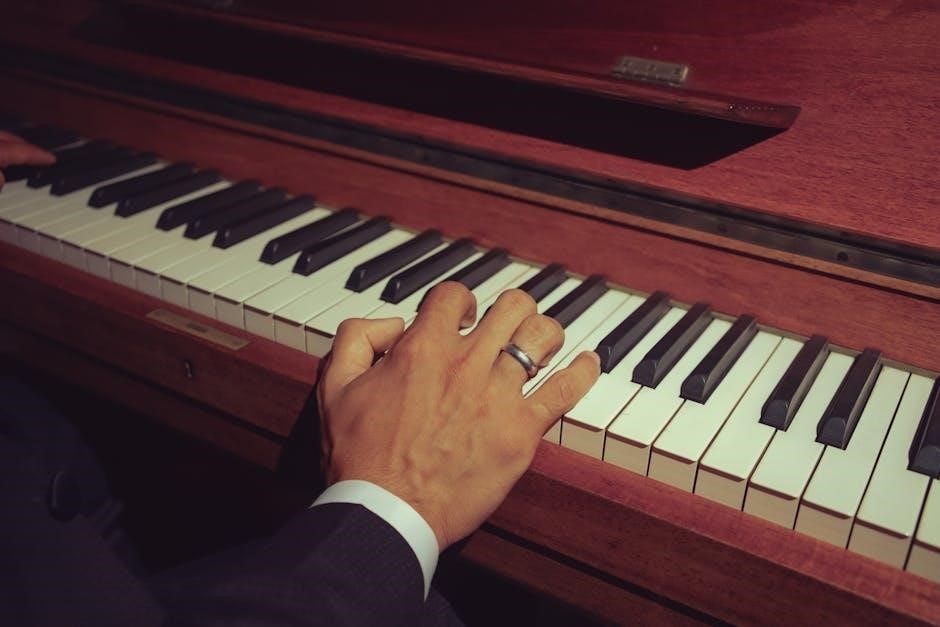
Understanding the Staff and Lines
The musical staff, with its five lines and four spaces, forms the foundation for notating treble clef notes, as seen in PDF guides․
These lines and spaces represent different pitches, enabling musicians to visually interpret melodies and harmonies․
PDF resources clarify this structure, aiding comprehension of musical notation․
The Music Staff Explained
The music staff is the fundamental framework upon which all written music resides․ Consisting of five horizontal lines and the four spaces between them, it provides the visual representation for pitch․
Each line and space corresponds to a specific note, and understanding this relationship is paramount to reading music effectively․
Treble clef notes, specifically, are positioned on this staff to indicate their pitch, and readily available treble clef notes PDF resources visually demonstrate this arrangement․
The staff’s lines and spaces are read from bottom to top, with lower pitches residing at the bottom and higher pitches at the top․
PDF guides often include diagrams illustrating the note placement, making it easier for beginners to associate each line and space with its corresponding note name․
The staff also utilizes ledger lines – short lines added above or below the staff – to extend the range of playable notes, further explained in comprehensive PDF tutorials․
Understanding the staff is the crucial first step in deciphering musical notation and unlocking the world of musical expression․
The seemingly unrelated references to Barbie games and watercolour paintings highlight the vastness of online content, but the focus remains on the structured learning offered by PDF resources․
Lines and Spaces – The Foundation
The lines and spaces of the treble clef staff are the bedrock of musical notation, representing distinct pitches essential for reading and playing music․
Each line and each space is assigned a specific note name, forming the foundation for understanding melodies and harmonies․
Utilizing a treble clef notes PDF is an excellent way to visually learn and memorize these note assignments, providing a clear and concise reference․
The lines, from bottom to top, represent E, G, B, D, and F, a common mnemonic being “Every Good Boy Deserves Fudge․”
The spaces, from bottom to top, spell out F, A, C, and E, easily remembered as “FACE․”
PDF resources often reinforce these mnemonics alongside visual representations of the staff, aiding in memorization․
Mastering the lines and spaces is crucial for accurately identifying notes and translating written music into sound․
While online content includes diverse topics like Barbie games and artwork, the core of music learning relies on understanding this fundamental structure, best supported by a dedicated PDF guide․

Treble Clef Note Names: A Comprehensive Guide
A treble clef notes PDF provides a systematic approach to learning note identification on the staff, crucial for musical literacy․
Understanding these names unlocks the ability to read and interpret countless musical pieces with confidence and precision․
This guide will detail each note’s position and name, building a strong foundation for musical understanding․
Notes on the Lines (EGBDF)
The lines of the treble clef staff represent specific musical notes, and a treble clef notes PDF often emphasizes memorizing these first․ Starting from the bottom line and moving upwards, the notes are E, G, B, D, and F – commonly remembered using the mnemonic “Every Good Boy Deserves Fudge․”
Visualizing these notes on the staff is key, and a well-designed PDF will include clear diagrams and exercises to reinforce this․ Understanding the relationship between the lines and the notes they represent is fundamental to reading music fluently․ Consistent practice with a PDF resource will solidify this knowledge․
The provided online content, while mentioning Barbie games and watercolour paintings, underscores the vastness of digital resources available․ However, focused learning tools like a treble clef notes PDF are essential for targeted skill development․ Mastering these line notes is a crucial first step in becoming proficient at reading music, enabling you to decode melodies and harmonies with greater ease․
Remembering EGBDF is the cornerstone of treble clef proficiency․
Notes in the Spaces (FACE)
The spaces between the lines of the treble clef staff also represent specific notes, and a comprehensive treble clef notes PDF will dedicate a section to these․ Reading the spaces is often easier for beginners, as they spell out the word “Face” – F, A, C, and E – from bottom to top․
A good PDF resource will visually highlight these spaces and provide exercises to practice identifying notes within them․ Combining knowledge of both line and space notes creates a complete understanding of the treble clef․ Consistent practice using a PDF guide is vital for building fluency․
The unrelated online references to Barbie games and artwork demonstrate the diverse content available online, but a focused PDF is superior for musical instruction․ Mastering the “FACE” notes complements the “EGBDF” line notes, forming a solid foundation for reading sheet music․ This skill unlocks the ability to interpret melodies and harmonies effectively․
Remembering FACE is essential for treble clef mastery․
Ledger Lines: Extending the Range
Beyond the five lines of the treble clef staff, ledger lines extend the range, allowing notation of notes both higher and lower․ A quality treble clef notes PDF will thoroughly explain these additions, demonstrating how they function to represent pitches outside the standard staff․ These short lines temporarily expand the staff’s capacity․
Understanding ledger lines is crucial for encountering notes frequently used in various instruments and musical styles․ A PDF guide will illustrate common ledger line notes and provide exercises for quick identification․ The seemingly unrelated online content – Barbie games and artwork – underscores the vastness of the internet, but a focused PDF offers targeted musical instruction․
Mastering ledger lines unlocks a wider repertoire, enabling musicians to play more complex pieces․ Consistent practice with a PDF resource builds confidence and accuracy in reading these extended notes․ Recognizing patterns and applying mnemonic devices aids memorization․
Ledger lines are essential for expanding musical horizons․
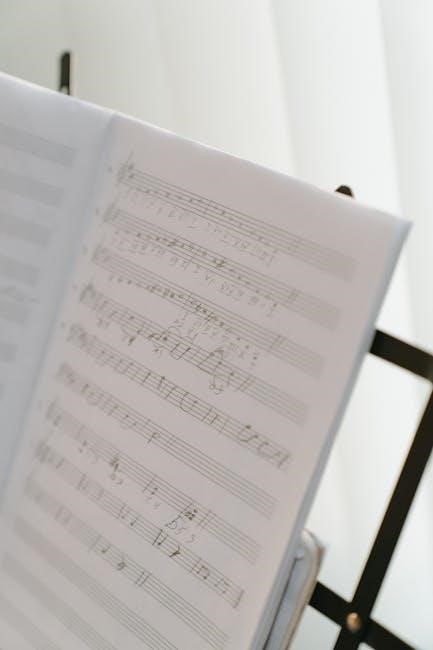
Common Treble Clef Notes and Their Values
A comprehensive treble clef notes PDF details note durations – whole, half, and quarter notes – and their corresponding rests․
Understanding these values is fundamental for rhythmic accuracy and musical interpretation․
These PDFs often include exercises to solidify rhythmic comprehension․
Whole Notes and Rests
A treble clef notes PDF will prominently feature the whole note, visually represented as an open oval․ This note receives four beats in 4/4 time, signifying the longest duration of a single note within common time signatures․
Its corresponding rest, the whole rest, hangs directly below the fourth line of the staff, appearing as a filled rectangle atop a stem․ Like the whole note, it also occupies four beats of silence․
PDF resources often illustrate how whole notes and rests establish the foundational pulse of a musical piece, providing a sense of stability and grounding․
Exercises within these PDFs frequently involve identifying whole notes and rests within musical excerpts, and calculating their duration in relation to the time signature․
The provided internet text, mentioning Barbie games and watercolour paintings, highlights the diverse digital landscape, where even musical learning resources are readily accessible․
Mastering the whole note and rest is crucial as it forms the basis for understanding shorter note values and complex rhythmic patterns, paving the way for confident music reading․
Half Notes and Rests
Treble clef notes PDFs clearly depict the half note as an open oval, similar to the whole note, but filled in․ It receives two beats in 4/4 time, representing half the duration of a whole note․
The half rest, visually distinct, appears as a filled rectangle sitting on the third line of the staff․ It signifies two beats of silence, mirroring the duration of the half note․
PDF worksheets commonly present exercises where students practice identifying half notes and rests within musical phrases, and calculating their rhythmic value․
These resources often emphasize the relationship between half notes and whole notes – two half notes combine to equal one whole note – reinforcing fundamental rhythmic concepts․
Interestingly, the online content referencing Barbie games and artwork demonstrates the vastness of the internet, where diverse information coexists alongside educational materials․
A solid understanding of half notes and rests is essential for accurately interpreting and performing music, building a strong rhythmic foundation for more complex musical structures․
Quarter Notes and Rests
Treble clef notes PDFs illustrate the quarter note as a filled-in oval with a stem extending upwards or downwards․ In 4/4 time, it receives one beat, forming the basic pulse of many musical pieces․
The quarter rest, a squiggly line, visually contrasts with the note․ It represents one beat of silence, crucial for rhythmic accuracy and musical phrasing․
PDF worksheets frequently include exercises focusing on recognizing quarter notes and rests within simple melodies, and clapping or counting their rhythmic values․
These materials often highlight that four quarter notes equal one whole note, or two quarter notes equal one half note, solidifying the proportional relationships between note durations․
The unrelated online references to Barbie games and watercolour paintings underscore the internet’s diverse content landscape, a stark contrast to focused musical instruction․
Mastering quarter notes and rests is fundamental for reading and performing music, providing the building blocks for more intricate rhythmic patterns and musical expression․
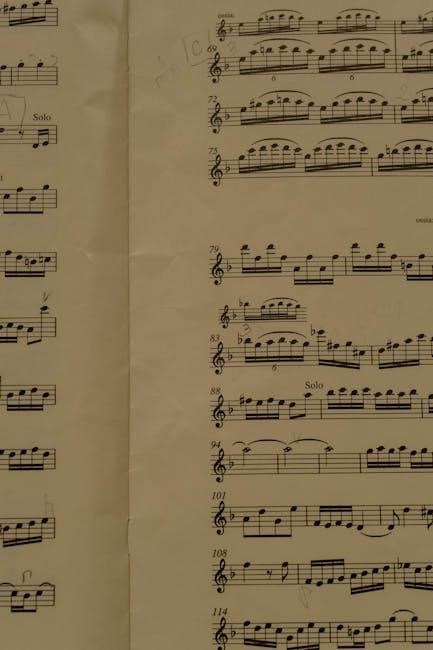
Resources for Treble Clef Note Learning
Numerous online resources, including free treble clef notes PDF worksheets, offer structured learning paths for beginners․
Interactive trainers and apps supplement these PDFs, providing engaging practice and reinforcing note recognition skills․
These tools, alongside unrelated Barbie game websites, empower musicians to learn efficiently and enjoyably․
Free Treble Clef Note PDF Worksheets
Embarking on your musical journey often begins with mastering the fundamentals, and free treble clef note PDF worksheets are an invaluable starting point․ These readily available resources provide a structured and accessible way to learn note recognition on the staff․
Many websites offer a diverse range of worksheets, catering to different skill levels – from absolute beginners to those seeking to refine their abilities․ You’ll find exercises focusing on identifying notes on lines and spaces, ledger line practice, and even worksheets incorporating rhythmic values․
The beauty of PDFs lies in their portability and convenience; you can download and print them for offline practice, making them ideal for learning on the go․ While seemingly unrelated, the abundance of online content, like Barbie game websites mentioned elsewhere, demonstrates the vastness of digital resources available․
Utilizing these worksheets consistently, alongside other learning tools, will significantly accelerate your progress in reading and understanding music․ They provide a tangible way to reinforce concepts and build a solid foundation for future musical endeavors․
Remember to choose worksheets that align with your current skill level and gradually increase the difficulty as you improve․
Online Treble Clef Note Trainers
Complementing traditional methods like PDF worksheets, online treble clef note trainers offer an interactive and engaging learning experience․ These digital tools utilize gamification and immediate feedback to accelerate note recognition skills․
Numerous websites and applications provide these trainers, often featuring customizable exercises that adapt to your progress․ You can typically choose to focus on specific notes, practice identifying notes in different clefs, or even test your speed and accuracy․
The interactive nature of these trainers is particularly beneficial, as it keeps you actively involved in the learning process․ Unlike static PDFs, they provide instant reinforcement, helping you solidify your understanding of note placement․
Interestingly, the internet’s diverse content, from musical resources to Barbie game platforms, highlights the accessibility of learning tools today․ These trainers, like downloadable PDFs, empower self-directed learning․
Regular use of online trainers, combined with consistent practice, will significantly improve your ability to read music fluently and confidently․
Explore different trainers to find one that suits your learning style․
Apps for Learning Treble Clef
Mobile applications dedicated to music theory, including treble clef note recognition, provide a convenient and portable learning solution․ These apps often build upon the foundational knowledge gained from resources like treble clef notes PDF guides, offering interactive exercises and personalized learning paths․
Many apps feature gamified lessons, turning note identification into a fun and challenging experience․ They frequently include features like timed quizzes, progress tracking, and customizable difficulty levels․
The portability of apps allows for practice anytime, anywhere, making it easier to integrate learning into your daily routine․ This contrasts with traditional methods, offering flexibility and accessibility․
The internet’s vast array of content, ranging from musical instruction to entertainment like online Barbie games, demonstrates the diverse digital landscape․ Apps represent a focused segment of this landscape․

Combining app-based learning with PDF worksheets creates a well-rounded approach, reinforcing concepts through different modalities․ Consistent practice with these tools will accelerate your musical literacy․
Download a few and see which one best fits your needs!

Tips for Memorizing Treble Clef Notes
Utilize mnemonics and flashcards alongside treble clef notes PDF resources for effective memorization․
Consistent practice, even in short bursts, is vital for solidifying your understanding․
Engage with interactive apps to reinforce learning!
Mnemonics and Memory Aids
Employing mnemonics is a cornerstone of effectively memorizing treble clef notes, particularly when supplementing study with treble clef notes PDF materials․ For the lines (EGBDF), the classic phrase “Every Good Boy Deserves Fudge” provides a memorable anchor․
Similarly, the spaces (FACE) conveniently spell out a word, simplifying recall․ These simple devices transform abstract note names into relatable concepts, boosting retention․
Beyond these standard mnemonics, personalize your own! Create phrases or stories that resonate with you, linking notes to vivid imagery or personal experiences․
Consider visual aids – color-coding notes on a PDF worksheet or associating each note with a specific object can enhance memory․
The internet references Barbie games and watercolour paintings, seemingly unrelated, but illustrate the power of association; apply this principle to music!
Regularly revisit these mnemonics during practice sessions to reinforce the connections and ensure long-term recall․
Flashcard Techniques
Flashcards represent a highly effective method for mastering treble clef notes, especially when paired with downloadable treble clef notes PDF resources․ Create cards displaying a note on one side and its corresponding name on the other․
Begin by focusing on a small set of notes, gradually increasing the complexity as your proficiency grows․ Regularly shuffle the deck to prevent rote memorization of the order․
Implement spaced repetition: review cards more frequently when initially learning, then gradually increase the intervals between reviews․ This optimizes long-term retention․
Categorize flashcards – separate cards for line notes, space notes, and ledger line notes for targeted practice․
The provided text mentions Barbie games and artwork, demonstrating how diverse content can be organized; apply this to your flashcard system!
Utilize digital flashcard apps for added convenience and features like progress tracking and adaptive learning․ Consistent, focused practice with flashcards will accelerate your note-reading skills․
Consistent Practice is Key
Consistent practice is paramount when learning treble clef notes, even more so when utilizing resources like treble clef notes PDF worksheets․ Short, frequent sessions are far more effective than infrequent, lengthy ones․
Aim for at least 15-20 minutes of dedicated practice daily, focusing on note recognition and recall․ Integrate practice into your routine, similar to a daily habit․
Combine PDF exercises with other learning methods, such as flashcards or online trainers, for a well-rounded approach․ Don’t just passively read the PDF; actively engage with the material․
The online content referencing Barbie games and artwork illustrates the importance of varied engagement – apply this principle to your musical studies․
Track your progress to stay motivated and identify areas needing improvement․ Celebrate small victories to reinforce positive learning habits․
Remember, mastery takes time and dedication․ Consistent effort, coupled with effective resources, will unlock your musical potential․

Treble Clef Notes in Different Instruments
Treble clef notes, learned via PDF resources, translate across instruments like piano, guitar, and flute․
Understanding the notes’ positions remains consistent, regardless of the instrument’s timbre or technique․
Adapt your learning to your chosen instrument, applying the foundational knowledge gained from PDF guides․
Piano and Keyboard
For piano and keyboard players, mastering treble clef notes is absolutely fundamental․ The right hand typically reads treble clef, navigating melodies and higher-register harmonies․
Utilizing treble clef notes PDF worksheets specifically designed for piano can accelerate learning, focusing on common patterns and finger placements․
These PDFs often include exercises that correlate notes to keys, building muscle memory and reinforcing visual recognition․
Beginners should start with identifying notes on the lines and spaces (EGBDF and FACE), gradually expanding their range with ledger lines․
The keyboard’s visual layout aids in associating notes with physical locations, making the learning process more intuitive․
Consistent practice with PDF-based drills, combined with playing simple melodies, will solidify understanding․
Remember that the treble clef represents higher pitches, crucial for creating balanced and expressive piano arrangements․
Don’t overlook the importance of rhythm, as accurate note reading must be paired with precise timing․
The provided online content, though mentioning Barbie games and watercolour paintings, underscores the vast availability of learning resources․
Leverage these digital tools alongside your PDF worksheets to create a comprehensive and engaging learning experience․
Guitar and Other String Instruments
While guitar traditionally uses tabulature, understanding treble clef notes is incredibly beneficial, especially when reading standard notation for classical or jazz guitar․
Treble clef notes PDF resources can bridge the gap, translating written music into fretboard positions․
These PDFs often demonstrate how notes correspond to specific strings and frets, aiding in visualization and technique․
For instruments like the violin, viola, and mandolin, treble clef is the primary notation system, making note recognition essential․
Learning to read treble clef expands a string player’s musical horizons, allowing access to a wider repertoire․
Focus on identifying notes within the instrument’s playable range, utilizing PDF exercises tailored to string instruments․
Understanding intervals and chord shapes becomes easier with a solid grasp of treble clef notation․
Consistent practice with PDF worksheets, combined with playing scales and arpeggios, will build fluency․
The seemingly unrelated online content – Barbie games and artwork – highlights the abundance of digital resources available․
Combine these with focused PDF study to unlock a deeper understanding of music theory and performance․
Flute and Other Wind Instruments
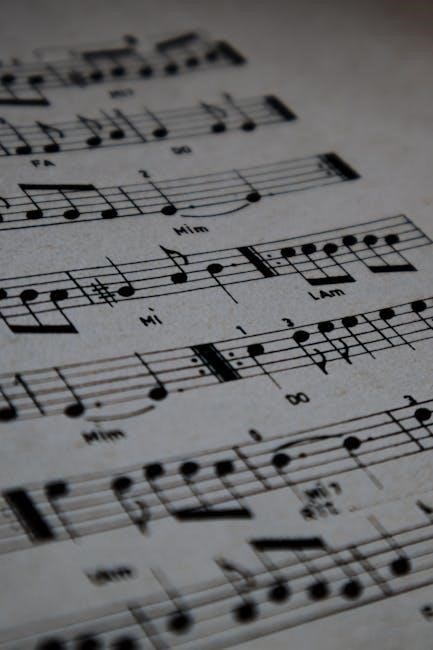
Flute, clarinet, oboe, and saxophone (typically in treble clef) rely heavily on reading standard musical notation․
Therefore, mastering treble clef notes is paramount for wind instrument players․
Treble clef notes PDF resources provide targeted practice, focusing on the range commonly used by these instruments․
These PDFs often include exercises designed to improve sight-reading skills, crucial for ensemble playing and solo performance․
Understanding note values and rhythmic patterns, alongside note names, is essential for accurate interpretation․
Utilize PDF worksheets that emphasize the relationship between notes and fingerings on your specific instrument․
Consistent practice with these resources will build muscle memory and enhance your ability to quickly identify notes․
The provided online content, referencing Barbie games and artwork, demonstrates the vastness of the digital landscape․
However, focused study with dedicated treble clef PDF materials remains the most effective path to proficiency․
A strong foundation in treble clef unlocks a wealth of musical possibilities for wind instrument musicians․
